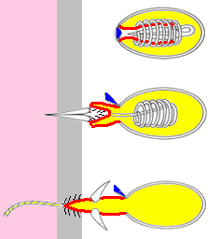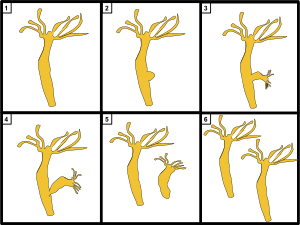Hydra (genus)
| Hydra | |
|---|---|

| |
| Hydra budding | |
| Scientific classification | |
| Domain: | Eukaryota |
| Kingdom: | Animalia |
| Phylum: | Cnidaria |
| Class: | Hydrozoa |
| Order: | Anthoathecata |
| Family: | Hydridae Dana, 1846 |
| Genus: | Hydra Linnaeus, 1758[1] |
| Species[1] | |
|
List
| |
Hydra (
Morphology

Hydra has a tubular,
At the free end of the body is a mouth opening surrounded by one to twelve thin, mobile
Hydra has two main body layers, which makes it "
Respiration and excretion occur by diffusion throughout the surface of the epidermis, while larger excreta are discharged through the mouth.[7][8]
Nervous system
The nervous system of Hydra is a nerve net, which is structurally simple compared to more derived animal nervous systems. Hydra does not have a recognizable brain or true muscles. Nerve nets connect sensory photoreceptors and touch-sensitive nerve cells located in the body wall and tentacles.
The structure of the nerve net has two levels:
- level 1 – sensory cells or internal cells; and
- level 2 – interconnected ganglion cells synapsed to epithelial or motor cells.
Some have only two sheets of neurons.[9]
Motion and locomotion

If Hydra are alarmed or attacked, the tentacles can be retracted to small buds, and the body column itself can be retracted to a small gelatinous sphere. Hydra generally react in the same way regardless of the direction of the stimulus, and this may be due to the simplicity of the nerve nets.
Hydra are generally
Reproduction and life cycle

- Non-reproducing
- Creating a bud
- Daughter growing out
- Beginning to cleave
- Daughter broken off
- Daughter clone of parent
Most hydra species do not have any gender system. Instead, when food is plentiful, many Hydra reproduce asexually by budding. The buds form from the body wall, grow into miniature adults and break away when mature.
When a hydra is well fed, a new bud can form every two days.[10] When conditions are harsh, often before winter or in poor feeding conditions, sexual reproduction occurs in some Hydra. Swellings in the body wall develop into either ovaries or testes. The testes release free-swimming gametes into the water, and these can fertilize the egg in the ovary of another individual. The fertilized eggs secrete a tough outer coating, and, as the adult dies (due to starvation or cold), these resting eggs fall to the bottom of the lake or pond to await better conditions, whereupon they hatch into nymph Hydra. Some Hydra species, like Hydra circumcincta and Hydra viridissima, are hermaphrodites[11] and may produce both testes and ovaries at the same time.
Many members of the
Feeding
Hydra mainly feed on aquatic invertebrates such as
While feeding, Hydra extend their body to maximum length and then slowly extend their tentacles. Despite their simple construction, the tentacles of Hydra are extraordinarily extensible and can be four to five times the length of the body. Once fully extended, the tentacles are slowly maneuvered around waiting for contact with a suitable prey animal. Upon contact, nematocysts on the tentacle fire into the prey, and the tentacle itself coils around the prey. Most of the tentacles join in the attack within 30 seconds to subdue the struggling prey. Within two minutes, the tentacles surround the prey and move it into the open mouth aperture. Within ten minutes, the prey is engulfed within the body cavity, and digestion commences. Hydra can stretch their body wall considerably.[citation needed]
The feeding behaviour of Hydra demonstrates the sophistication of what appears to be a simple nervous system.
Some species of Hydra exist in a mutual relationship with various types of unicellular algae. The algae are protected from predators by Hydra; in return, photosynthetic products from the algae are beneficial as a food source to Hydra[13][14], and even help to maintain the Hydra microbiome.[15]
Measuring the feeding response

The feeding response in Hydra is induced by glutathione (specifically in the reduced state as GSH) released from damaged tissue of injured prey.[16] There are several methods conventionally used for quantification of the feeding response. In some, the duration for which the mouth remains open is measured.[17] Other methods rely on counting the number of Hydra among a small population showing the feeding response after addition of glutathione.[18] Recently, an assay for measuring the feeding response in hydra has been developed.[19] In this method, the linear two-dimensional distance between the tip of the tentacle and the mouth of hydra was shown to be a direct measure of the extent of the feeding response. This method has been validated using a starvation model, as starvation is known to cause enhancement of the Hydra feeding response.[19]
Predators
The species Hydra oligactis is preyed upon by the flatworm Microstomum lineare.[20][21]
Tissue regeneration
Hydras undergo morphallaxis (tissue regeneration) when injured or severed. Typically, Hydras reproduce by just budding off a whole new individual; the bud occurs around two-thirds of the way down the body axis. When a Hydra is cut in half, each half regenerates and forms into a small Hydra; the "head" regenerates a "foot" and the "foot" regenerates a "head". This regeneration occurs without cell division. If the Hydra is sliced into many segments, the middle slices form both a "head" and a "foot".[6] The polarity of the regeneration is explained by two pairs of positional value gradients. There is both a head and foot activation and inhibition gradient. The head activation and inhibition works in an opposite direction of the pair of foot gradients.[22] The evidence for these gradients was shown in the early 1900s with grafting experiments. The inhibitors for both gradients have shown to be important to block the bud formation. The location where the bud forms is where the gradients are low for both the head and foot.[6]
Hydras are capable of regenerating from pieces of tissue from the body and additionally after tissue dissociation from reaggregates.[22] This process takes place not only in the pieces of tissue excised from the body column, but also from re-aggregates of dissociated single cells. It was found that in these aggregates, cells initially distributed randomly undergo sorting and form two epithelial cell layers, in which the endodermal epithelial cells play more active roles in the process. Active mobility of these endodermal epithelial cells forms two layers in both the re-aggregate and the re-generating tip of the excised tissue. As these two layers are established, a patterning process takes place to form heads and feet.[23]
Non-senescence
Daniel Martinez claimed in a 1998 article in Experimental Gerontology that Hydra are biologically immortal.[24] This publication has been widely cited as evidence that Hydra do not senesce (do not age), and that they are proof of the existence of non-senescing organisms generally. In 2010, Preston Estep published (also in Experimental Gerontology) a letter to the editor arguing that the Martinez data refutes the hypothesis that Hydra do not senesce.[25]
The controversial unlimited lifespan of Hydra has attracted much attention from scientists. Research today appears to confirm Martinez' study.
In bilaterally symmetrical organisms (Bilateria), the transcription factor FoxO affects stress response, lifespan, and increase in stem cells. If this transcription factor is knocked down in bilaterian model organisms, such as fruit flies and nematodes, their lifespan is significantly decreased. In experiments on H. vulgaris (a radially symmetrical member of phylum Cnidaria), when FoxO levels were decreased, there was a negative effect on many key features of the Hydra, but no death was observed, thus it is believed other factors may contribute to the apparent lack of aging in these creatures.[5]
DNA repair
Hydra are capable of two types of DNA repair: nucleotide excision repair and base excision repair.[27] These repair pathways facilitate DNA replication by removing DNA damage. The identification of these pathways in hydra was based, in part, on the presence in the hydra genome of genes homologous to genes in other genetically well studied species that have been demonstrated to play key roles in these DNA repair pathways.[27]
Genomics
An
The genomes of
Due to the simplicity of their life cycle when compared to other hydrozoans, hydras have lost many genes that correspond to cell types or metabolic pathways of which the ancestral function is still unknown.
Hydra genome shows a preference towards proximal promoters. Thanks to this feature, many reporter cell lines have been created with regions around 500 to 2000 bases upstream of the gene of interest. Its cis-regulatory elements (CRE) are mostly located less than 2000 base pairs upstream from the closest transcription initiation site, but there are CREs located further away.
Its chromatin has a Rabl configuration. There are interactions between the centromeres of different chromosomes and the centromeres and telomeres of the same chromosome. It presents a great number of intercentromeric interactions when compared to other cnidarians, probably due to the loss of multiple subunits of condensin II. It is organized in domains that span dozens to hundreds of megabases, containing epigenetically co-regulated genes and flanked by boundaries located within heterochromatin.[31]
Transcriptomics
Different Hydra cell types express gene families of different evolutionary ages.
See also
- Lernaean Hydra, a Greek mythological aquatic creature after which the genus is named
- Turritopsis dohrnii, another cnidarian (a jellyfish) that scientists believe to be immortal
References
- ^ a b Schuchert P (2011). Schuchert P (ed.). "Hydra Linnaeus, 1758". World Hydrozoa database. World Register of Marine Species. Retrieved 20 December 2011.
- ^ Gilberson L (1999). Zoology Lab Manual (4th ed.). Primis Custom Publishing.
- Brooks/Cole.
- S2CID 3887876.
- ^ PMID 26120246.
- ^ a b c Gilbert SF (2000). "Regeneration". Developmental Biology (6th ed.).
- ^ "Olympus Microscopy Resource Center | Pond Life Video Gallery – Hydra (Coelenterata)". olympus.magnet.fsu.edu. Retrieved 21 September 2019.
- S2CID 86961916.
- PMID 28441559.
- ^ Patton WK (August 2014). "Hydra (coelenterate)". Grolier Multimedia Encyclopedia. Grolier Online.
- ISBN 978-3-8274-0836-5.
- OCLC 1097367369.)
{{cite book}}: CS1 maint: location missing publisher (link - S2CID 21008864.
- S2CID 28578967.
- PMID 35733963.
- S2CID 85570550.
- S2CID 29262166.
- PMID 2888575.
- ^ PMID 25490534.
- PMID 29661512.
- S2CID 209380951.
- ^ S2CID 26953455.
- S2CID 26953455.
- S2CID 2009972.
- S2CID 35408542.
- ^ PMID 23150562.
- ^ PMID 33995496.
- ^ "Transgenic Hydra Facility, University of Kiel (Germany)".
- PMID 20228792.
- PMID 31659034.
- ^ PMID 36639202.
